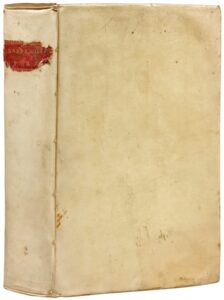In quadrantem tum Astronomicum, tum geometricum, nec non in Astrolabium, Introductio. Omnibus militiae Prefectis, machinarum Magistris, Mercaturam exercentibus, Geodaetis, Mari iter facientibus, ac Mathesi addictis, apprime utilis. Belgice ab Autore scripta ; nunc vero Latina prodit, opera, Middelburg, Z. Romanum, [sed in fine: Harlemi, ex off. A. Romani, 1635]. Folio of 28 pp., (1) l. of index and 2 double-page plates of astronomical and geometrical quadrants drawn in 1628; (1) bl. l. First edition. J. de La Lande, Bibliographie astronomique, p.205.
– [Followed by]: LANSBERG, Philipp. Sphaera Plana à Ptolomaeo Astrolabium dicta. Ex Lingua Belgica in Romanam translata. Interprete I. Francio Sil. Middelburg, Z. Romanum, 1636. Folio of 25 pp., (2) pp. of table and 2 double-page astronomical plates. First edition.
These two works are included in:
–LANSBERG, Philip. Opera Omnia. Middelburg, Zachariam Roman, 1663. Folio of: (8) ll., 118 pp. with (2) ll. between pp. 88-89 (Astronomi Celeberrimi); (5) ll., 74 pp., (1) bl. l. (Uranometriae, Libri Tres); (3) ll., 53 pp. (1) bl. p. (Horlogiographia Plana); (4) ll., 34 pp. and 1 folding plate between pp. 18-19, (1) bl.l. (Commentationes in motum terrae…); (6) ll., 41 pp., (1) p. bl. (Tabulae motuum coelestium perpetuae …); (1) l. of title, 180 pp., 1 folding table on double page, 181 pp., (3) (Tabulae motuum coelestium perpetuae …); (2) ll., 103 pp., (1) bl.p. (Chronologiae Sacrae).
3 works in 1 folio volume, full overlapping vellum, flat spine, red morocco lettering piece, sprinkled edges. Handwritten ex libris and stamp on the half-title. Contemporary binding.
285 x 180 mm.
Extremely rare first edition of “Quadrantem tum astronomicum in astrolabium” by the Belgian mathematician Philip Lansberg (1561-1632) printed in 1635 of which Kepler “profitably used the trigonometric tables by Lansbergen”. No complete copy of this superb first edition has appeared on the public international market since half a century and only 3 copies are listed by Grassi in: Leyden, Stockholm and Uppsala.
First edition quite as rare as the previous one of the “Sphaera plana a Ptolomaeo astrolabium” printed in 1636 of which no copy has been recorded on the public market since half a century and of which only three copies are listed by Grassi: Leyden, Stockholm and Uppsala.
First collective edition of the “Opera Omnia”, a superb volume printed in 1663. Brunet, III, 825.
Lalande owned a copy of this superb volume and the “Opera Omnia” probably influenced Delambre.
The first two treatises of the Opera Omnia form Lansberg’s mathematical work. A rectilinear and spherical trigonometry, and a cyclometry; the others deal with the astronomical dial, the Astrolabe and the Sundial, and give astronomical tables.
Lansberg was in favor of Copernicus and Kepler’s ideas (of which he did not accept the elliptic form of planet orbits), what brought him many troubles from Protestant ministers. His parents raised him in the Protestant religion to which he always remained attached. He studied in England, then came back to Ghent, then left once again his home town to settle in Antwerp towards 1580. When in 1585, the commercial city turned again under Philip II of Spain’s authority, he left Belgium to settle in the Netherlands, in Leyden, where he professed as a minister then in Ter-Goes and in Middleburg, where he practiced medicine and was able to dedicate himself to his favorite studies, math and astronomy. He was Simon Stevin’s pupil in Leyden, and became friend with Willebrond Snell who was sharing the same passion. He died in Middleburg on November 8t 1635. Tallemant des Reaux notes in his anecdotes that he was one of the few Europeans to understand François Viete’s algebra; Kepler uses his calculations.
The Opera Omnia are certainly less rare than the two first editions mentioned above, bound in the volume, and according to Grassi we can find copies in Bologna, Bonn, Brussels, Edinburg, Greenwich, Hamburg, Leyden, Strasbourg and Uppsala, however only one complete copy appeared on the public market during the last half century: “Honeyman’s copy, Sotheby’s 12/05/1980 in a later restored binding with wormholes”.
A magnificent copy preserved in its very pure contemporary vellum, containing 3 works by Lansberg, of which two unobtainable texts, coming from the collection of the Counts of Peren with ex libris).
See less information







